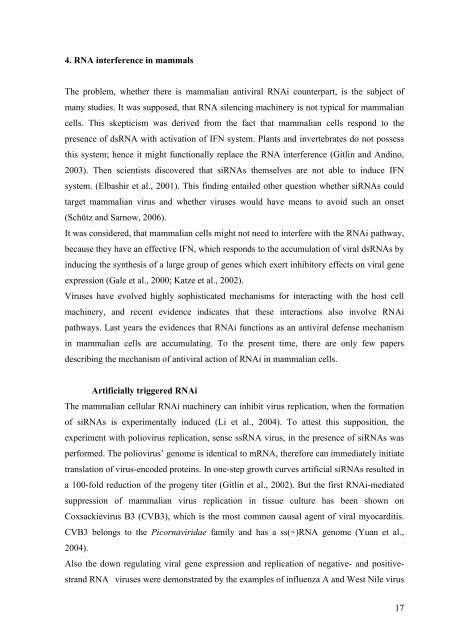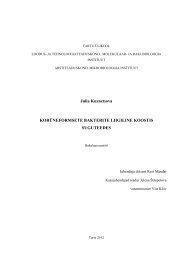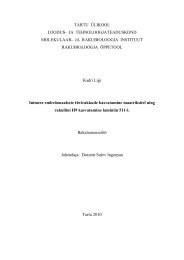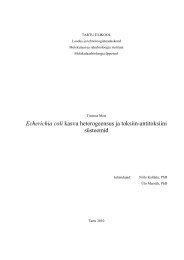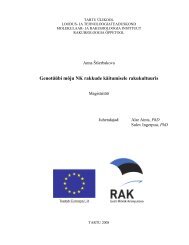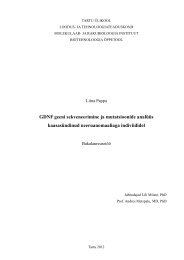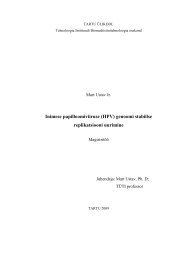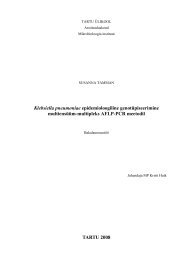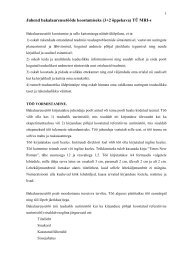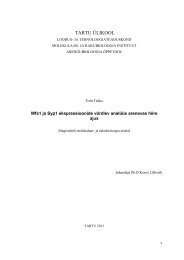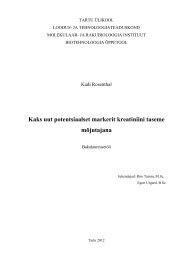Viruses and RNA interference in mammalian cells
Viruses and RNA interference in mammalian cells
Viruses and RNA interference in mammalian cells
Create successful ePaper yourself
Turn your PDF publications into a flip-book with our unique Google optimized e-Paper software.
4. <strong>RNA</strong> <strong><strong>in</strong>terference</strong> <strong>in</strong> mammals<br />
The problem, whether there is <strong>mammalian</strong> antiviral <strong>RNA</strong>i counterpart, is the subject of<br />
many studies. It was supposed, that <strong>RNA</strong> silenc<strong>in</strong>g mach<strong>in</strong>ery is not typical for <strong>mammalian</strong><br />
<strong>cells</strong>. This skepticism was derived from the fact that <strong>mammalian</strong> <strong>cells</strong> respond to the<br />
presence of ds<strong>RNA</strong> with activation of IFN system. Plants <strong>and</strong> <strong>in</strong>vertebrates do not possess<br />
this system; hence it might functionally replace the <strong>RNA</strong> <strong><strong>in</strong>terference</strong> (Gitl<strong>in</strong> <strong>and</strong> And<strong>in</strong>o,<br />
2003). Then scientists discovered that si<strong>RNA</strong>s themselves are not able to <strong>in</strong>duce IFN<br />
system. (Elbashir et al., 2001). This f<strong>in</strong>d<strong>in</strong>g entailed other question whether si<strong>RNA</strong>s could<br />
target <strong>mammalian</strong> virus <strong>and</strong> whether viruses would have means to avoid such an onset<br />
(Schütz <strong>and</strong> Sarnow, 2006).<br />
It was considered, that <strong>mammalian</strong> <strong>cells</strong> might not need to <strong>in</strong>terfere with the <strong>RNA</strong>i pathway,<br />
because they have an effective IFN, which responds to the accumulation of viral ds<strong>RNA</strong>s by<br />
<strong>in</strong>duc<strong>in</strong>g the synthesis of a large group of genes which exert <strong>in</strong>hibitory effects on viral gene<br />
expression (Gale et al., 2000; Katze et al., 2002).<br />
<strong>Viruses</strong> have evolved highly sophisticated mechanisms for <strong>in</strong>teract<strong>in</strong>g with the host cell<br />
mach<strong>in</strong>ery, <strong>and</strong> recent evidence <strong>in</strong>dicates that these <strong>in</strong>teractions also <strong>in</strong>volve <strong>RNA</strong>i<br />
pathways. Last years the evidences that <strong>RNA</strong>i functions as an antiviral defense mechanism<br />
<strong>in</strong> <strong>mammalian</strong> <strong>cells</strong> are accumulat<strong>in</strong>g. To the present time, there are only few papers<br />
describ<strong>in</strong>g the mechanism of antiviral action of <strong>RNA</strong>i <strong>in</strong> <strong>mammalian</strong> <strong>cells</strong>.<br />
Artificially triggered <strong>RNA</strong>i<br />
The <strong>mammalian</strong> cellular <strong>RNA</strong>i mach<strong>in</strong>ery can <strong>in</strong>hibit virus replication, when the formation<br />
of si<strong>RNA</strong>s is experimentally <strong>in</strong>duced (Li et al., 2004). To attest this supposition, the<br />
experiment with poliovirus replication, sense ss<strong>RNA</strong> virus, <strong>in</strong> the presence of si<strong>RNA</strong>s was<br />
performed. The poliovirus’ genome is identical to m<strong>RNA</strong>, therefore can immediately <strong>in</strong>itiate<br />
translation of virus-encoded prote<strong>in</strong>s. In one-step growth curves artificial si<strong>RNA</strong>s resulted <strong>in</strong><br />
a 100-fold reduction of the progeny titer (Gitl<strong>in</strong> et al., 2002). But the first <strong>RNA</strong>i-mediated<br />
suppression of <strong>mammalian</strong> virus replication <strong>in</strong> tissue culture has been shown on<br />
Coxsackievirus B3 (CVB3), which is the most common causal agent of viral myocarditis.<br />
CVB3 belongs to the Picornaviridae family <strong>and</strong> has a ss(+)<strong>RNA</strong> genome (Yuan et al.,<br />
2004).<br />
Also the down regulat<strong>in</strong>g viral gene expression <strong>and</strong> replication of negative- <strong>and</strong> positivestr<strong>and</strong><br />
<strong>RNA</strong> viruses were demonstrated by the examples of <strong>in</strong>fluenza A <strong>and</strong> West Nile virus<br />
17


